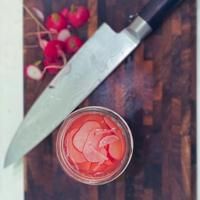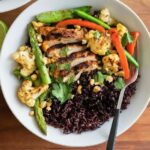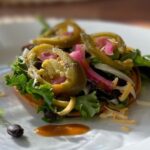We recommend products we would use ourselves and all opinions expressed here are our own. This post may contain affiliate links, which means we might make a small commission at no extra cost to you. This helps us keep the blog running. See our full disclosure here.
Also known as refrigerator pickling, quick pickling is a versatile and convenient technique I use repeatedly in my kitchen. You can master quick pickling for any veggie in about 10 minutes.
Pickling transforms an array of fresh vegetables and fruits into crunchy, tangy treats. Whether you’re looking to rescue that surplus of carrots or capture the essence of seasonal produce, pickling offers a simple and flavorful solution.
If you like food history and knowledge, Wikipedia has an interesting article on quick pickling‘s history and world-wide usage.
Quick Pickling Essentials
For quick pickling, you’ll need some essentials: vinegar, water, salt, sugar (optional), and possibly an array of spices. If you want to keep things fast and simple as I do every week, then solely using salt, distilled vinegar, and water make delicious quick pickles without much fuss.
Equipment
You need jars and lids for the pickling process. In particular, we like to either use 4 oz Ball jars, 8 oz Ball jars, or a variety of sizes of Weck jars. For mason jars, we use reusable silicon lids — we love that they fit a variety of different jar tops.
Flavoring
The beauty of quick pickling lies in its flexibility; you can experiment with various vinegars, spices, and any veggie to craft unique and flavorful combinations. For added zest, consider using different types of vinegar like white wine vinegar, apple cider vinegar, or rice vinegar. Even more, try experimenting with spices such as garlic cloves, peppercorns, dill seeds, mustard seeds, or red pepper flakes to create your signature pickling blend.
Step-by-Step Guide to Quick Pickling for Any Veggie

Even though these are called ‘quick,’ quick pickles will be ready to eat within a day or two because time is needed for flavors to meld. Not only does ‘quick’ encompass how fast they are to make, but also in comparison to fermentation which can take weeks.
Vegetable pickles keep well in the refrigerator for a few weeks or longer, depending on your storage method.
Ratio to Make Quick Pickles with any Veggie
- 1:1 Vinegar to water
- 1.5 tablespoon salt : 2 cup liquid ratio
Dissolve the Salt
First thing to remember is to heat your water to boiling. Place your salt into your jar of choice and add a hot water to cover and dissolve the salt. If adding spices, then add them to the mixture as well.
Cut your Veggies

Cut veggies into rounds, rings, sticks or leave whole (green beans, baby carrots). Pack your prepared vegetables or fruits into the jars. Make sure they are tightly packed but not overcrowded. Leave about half an inch of space at the top. Add hot water so that half the jar is full.
Add Vinegar
Next, add vinegar to fill the jar; leave about 1/2 inch of headspace at the top of each jar.Add a pinch or so of sugar if desired and close the jar.
Wait

Last, gently tap the jars on the countertop to remove any air bubbles. You can also use a clean utensil to release trapped air. Allow the jars to cool to room temperature and then leave them on the counter overnight to let the flavors marry and steep. Finally, refrigerate and enjoy.
Versatile Vegetable Pickle Ideas

We keep a myriad of pickled veggies in various jar sizes in our fridge. As a matter of fact, almost any veggie you have on hand can be transformed with quick pickling:
- Cucumbers: Crisp and refreshing, cucumbers are the classic choice for making dill or bread-and-butter pickles.
- Carrots: Carrots add vibrant color and a sweet crunch to your quick pickles. Try rainbow carrots for a visually appealing mix.
- Red Onions: Quick-pickled red onions are a versatile condiment that pairs well with sandwiches, salads, and tacos.
- Radishes: Radishes offer a peppery bite and beautiful color. Moreover, they’re perfect for adding zing and interest to your dishes.
- Sweet Peppers: Sweet and colorful peppers are excellent for pickling and provide a delightful crunch.
- Jalapeños: Add a spicy kick to your pickling repertoire with jalapeño slices. And Adjust the heat level to your liking.
- Cauliflower: Cauliflower florets soak up the pickling flavors beautifully, therefore making them a great addition to any pickle medley.
- Green Beans: Quick-pickled green beans are known as “dilly beans” and are a tangy, crunchy snack.
- Cherry Tomatoes: Tiny but bursting with flavor, cherry tomatoes are a unique and delightful choice for pickling.
- Okra: Okra lovers, rejoice! Quick-pickled okra retains its distinctive texture and flavor.
- Zucchini: Thinly sliced zucchini makes for delicate and flavorful pickles, perfect for sandwiches and salads.
- Asparagus: Pickled asparagus spears add an elegant touch to charcuterie boards and salads.
- Beets: Vibrant as well as earthy, pickled beets are a classic favorite, often paired with goat cheese or in salads.
- Cabbage: Shredded cabbage can be quick-pickled for a tangy topping on tacos and hot dogs.
- Fresno Peppers: Fresno peppers offer a mild heat and vibrant red color, also making them a versatile pickling ingredient.
- Corn: Fresh corn kernels can be quick-pickled for a burst of sweetness and a delightful crunch.
Using Quick Pickled Veggies
Additionally, here are some creative ideas for incorporating vegetable pickles into your meals:

- Burgers: Upgrade your burger game by adding quick pickled red onions, jalapeños, or bread-and-butter pickles. The tangy crunch pairs perfectly with the juicy burger patties.
- Taco/Nacho Toppers: Sprinkle quick-pickled radishes, fresnos, or red onions over your favorite tacos. They not only provide a refreshing contrast to the savory and spicy taco fillings, but they also add a flair of sophistication to a simple meal.
- Salads: Toss quick-pickled vegetables into salads for an extra burst of flavor, color, and texture. Try pickled beets, cauliflower, sweet peppers, or green beans to liven up your greens.
- Sandwiches: Layer pickled cucumbers, peppers, or pickled red cabbage on sandwiches and wraps. The acidity balances the richness of deli meats and cheeses.
- Sushi: Serve quick-pickled ginger alongside homemade or takeout sushi. Its palate-cleansing properties make it an ideal accompaniment.
- Charcuterie Boards: Arrange a variety of quick pickles on your charcuterie board. They complement cured meats, cheeses, and crackers beautifully.
- Snacks: Enjoy quick pickles straight from the jar as a satisfying and guilt-free snack. A healthier alternative to chips or pretzels, you could also add them to kid’s lunches to get more vegetables in their meals.
- Barbecue: Pair quick pickles with grilled meats at your next barbecue. Pickled veggies offer a refreshing contrast to smoky flavors.
- Potluck: Bring quick-pickled vegetables to potluck gatherings. They’re a crowd-pleasing addition that adds vibrancy to any potluck spread.
- Hot Dogs: Top your hot dogs with a medley of pickled vegetables, from onions to hot peppers, for a gourmet twist on a classic favorite.
- Mixology Magic: Use pickled garnishes like pickled onions, carrots, or even asparagus in your cocktails. They add a unique twist to your drink presentation.
- Eggs: Elevate deviled eggs or egg salad sandwiches with a touch of pickled flavor. Quick-pickled red onions or gherkins work wonders here.
- Pizza: Add quick-pickled fresnos or banana peppers as a pizza topping. Jalapenos and red onions are great compliments for barbeque chicken pizza. The acidity cuts through the richness of cheese and meats.
- Chili: Sprinkle some pickled corn on top before serving for a delightful contrast in flavors and textures.
- Pasta Salad: Mix quick pickles into pasta salads for a tangy twist. Try pickled cucumbers, cherry tomatoes, or artichoke hearts.
In the same way as above, feel free to get creative and experiment with different pickling combinations. Quick pickled veggies can turn ordinary dishes into culinary adventures and is a delightful addition to your kitchen repertoire.
Any Veggie, Any Day
To summarize, quick pickling is a simple and versatile technique that allows you to savor the flavors of the season, preserve surplus produce, and add a tangy twist to your meals. With just a few basic ingredients and some creativity, you can create a variety of delightful pickles that elevate your dishes and make the most of what’s in your garden or market.
Finally, don’t be afraid to experiment with different vegetables and flavor combinations – quick pickling offers endless opportunities for pickling for any veggie. So, grab your jars, pick out your favorite veggies, and start pickling your way to vibrant, zesty bites that brighten your dishes. Happy pickling!
Try ToppingThese Meals with Quick Pickled Veggies










